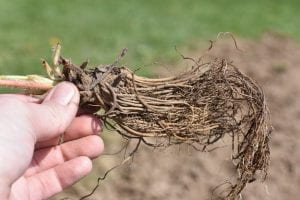I have all my seeds on order and can’t wait to get some of them started indoors.
Starting seeds indoors requires light, water, a container and soil mix, and fertilizer. In some cases, they need heat or warm soil to germinate – this depends on the seed variety.
Light is absolutely critical for success with seed starting. Think about the plants that you are growing and their normal growing conditions. Most of them thrive in full sun.
Now, think about the location in your house where you are going to start the seeds. You may need to supply supplemental lighting in order to meet the needs of the seeds. A bright west window is ok but still isn’t quite enough light for good growth.
Light needs to be available to the plant for at least 14-16 hours a day. The light source needs to be close to the plants, no more than two inches above the top of the plant. Light that is farther away leads to stretched plants.
You’ll see stretched plants if you are planting in a bright window without supplemental light. The plant reaches for the light, therefore, stretches and become lanky.

Make sure the container has drainage holes
Containers are also critical for success. No matter the container, make sure it has drainage holes to prevent accidental overwatering.
Gardeners use all types of containers, often recycling plastic take out and other containers. Just be sure to poke holes in the bottom for good drainage.
The seed starting mix is also critical for success. Garden soil is too heavy and usually leads to damping off or root rot because of poor drainage.
I purchase a soil mix that is labeled for seed starting. It’s lightweight and well-drained. I fill my flats and soak them with water to ensure that the soil is moist prior to seeding.
There are different methods to start the seeds. I like to seed everything in one flat and then transplant them into their final container after they develop a few sets of true leaves. Others like to directly sew them into their final container.
Watering is the most difficult task when it comes to plants. Figure out the water requirements for the plants and the soil mix that you are using. Pay close attention during the seedling stage to over- and underwatering. Overwatering leads to almost certain death. Err on the dry side, but don’t let the plants get to the wilting stage.
Fertilizer will be important a few weeks after seed starting and when the plants develop true leaves. The first leaves that emerge are the cotyledon leaves and provide nutrients to the emerging plant.

Don’t forget to add labels to your seedlings
Once the true leaves develop, photosynthesis begins, and the plant needs additional nutrients. Follow the directions on any liquid fertilizer for best success.
In terms of transplanting, as mentioned above, if you start the seeds with a seed starting mix, you may want to select a lightweight soilless mix for growing them on. This mix will hold a little more moisture for the larger plant while providing good drainage to prevent overwatering.
Growing your plants indoors is fun and not all that expensive. Give it a try!














 Like any vegetable garden, raised beds should be located in areas that receive a minimum of 6 to 8 hours of direct sunlight each day. Raised beds can be an option for utilizing sloped locations if the beds are terraced during construction. Ideally, raised beds should be located close to a water source to facilitate frequent irrigation. If you build several raised beds be sure to allow for adequate space between beds to facilitate working in each bed as well as maintenance of the beds.
Like any vegetable garden, raised beds should be located in areas that receive a minimum of 6 to 8 hours of direct sunlight each day. Raised beds can be an option for utilizing sloped locations if the beds are terraced during construction. Ideally, raised beds should be located close to a water source to facilitate frequent irrigation. If you build several raised beds be sure to allow for adequate space between beds to facilitate working in each bed as well as maintenance of the beds.








